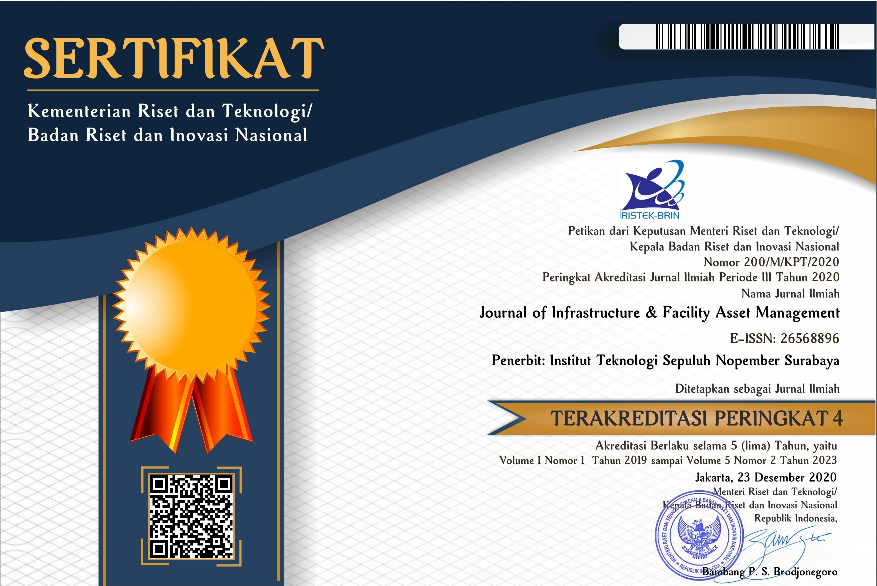Evaluation of Pump Capacity in Pancasila Pumping Station, Madiun City, East Java
Abstract
Madiun River catchment area is widely known for flooding in the rainy season. There is an embankment built to prevent the flood from entering the city. With the existence of the embankment, pumps are required to discharge the rainwater from the urban drainage channel into the river. The pumps located in the pumping stations are spread across the Madiun City. Each pumping station has a different capacity and different catchment areas. Nevertheless, its capacity is not sufficient to discharge the water flowing from the drainage channel into the river without causing flood in the city. Hence, the evaluation of pump capacity is necessary. In this study, a case study of Pancasila Pumping Station as a pumping station with the biggest catchment area is taken. From the rainfall data, flood discharge in the inlet of the pumping station is calculated using a synthetic unit hydrograph of the Nakayasu method. The capacity of the pump will be evaluated using the resulted flood discharge, whether the capacity is sufficient or not. Furthermore, the necessary pump quantity, the pump capacity, the operational hours, and the volume storage needed will be calculated. The results are: maximum flood discharge with a return period of 10 years is 20.206 m³/s, the existing pump capacity is only 1,000 litre per second while the required pump capacity is 5 m³/s with the quantity of two units, both operated in the same time for 8 hours and one unit is operated for the ninth hour, equipped with a storage volume of 102,017 m³. Thus, the addition of pump capacity is necessary.
Full Text:
PDFReferences
Arora, K. & Singh, V. P. (1989). “A comparative evaluation of the estimators of the log Pearson type (LP) 3 distribution”. Journal of Hydrology (Elsevier) Volume 105, Issues 1–2, 30 January 1989, Pages 19-37. https://doi.org/10.1016/0022-1694(89)90094-2
Bharali, B. (2015). “Estimation of Reservoir Storage Capacity by using Residual Mass Curve”. Journal of Civil Engineering and Environmental Technology, Volume 2, Number 10; April-June, 2015 pp. 15-18.
Chow, V. T., Maidment, D. R. & Mays, L. W. (1988). Applied Hydrology. Austin, T.X. : McGraw-Hill, 1988.
Maulana, M. A., Suprayitno, H. & Soemitro, R. A. A. (2019). “Preliminary Recognition of River Infrastructure”. Journal of Infrastructure & Facility Asset Management – Vol. 1, Issue 1, March 2019.
Ponce, V. M. (1989). Engineering Hydrology: Principles and Practices. Englewood Cliffs, N.J. : Prentice-Hall, 1989.
Priambodo, S., Suhardjono, Montarcih, L. & Suhartanto E. (2019). “Hourly rainfall distribution patterns in Java island”. MATEC Web of Conferences 276, 04012. https://doi.org/10.1051/matecconf/201927604012
Safarina, A. B., Salim, H. T., Hadihardaja, I. K. & Syahril, M. (2011). “Clusterization of Synthetic Unit Hydrograph Methods Based on Watershed Characteristics”. International Journal of Civil and Environmental Engineering, 11(06), 2011, 76-85.
Soemitro, R. A. A. & Suprayitno, H. (2018). “Preliminary Reflexion on Basic Concept of Facility Asset Management”. Jurnal Manajemen Aset Infrastruktur & Fasilitas – Vol. 2, Sup. 1, Juni 2018.
Subramanya, K. (2008). Engineering Hydrology. New Delhi, India : Tata McGraw-Hill, 2008.
Suprayitno, H. & Soemitro, R. A. A. (2018). “Preliminary Reflexion on Basic Principle of Infrastructure Asset Management”. Jurnal Manajemen Aset Infrastruktur & Fasilitas – Vol. 2, No. 1, Maret 2018.
Suprayitno, H. & Soemitro, R. A. A. (2019). “Reflection on Basic View of Public Infrastructure for Infrastructure Asset Management in Indonesia”. Jurnal Manajemen Aset Infrastruktur & Fasilitas – Vol. 3, Sup. 1, Juni 2019.
DOI: http://dx.doi.org/10.12962%2Fjifam.v2i2.7018
Refbacks
- There are currently no refbacks.
Visitor :
Flag Counter

Journal Of Infrastructure & Facility Asset Management by Institut Teknologi Sepuluh Nopember is licensed under a Creative Commons Attribution-ShareAlike 4.0 International License.
http://earthlearning.unimol.it/
Kementerian Pemberdayaan Perempuan dan Perlindungan Anak Indonesia
BRIN - Badan Riset dan Inovasi Nasional
https://www.cityofnorthfield.org/
Website Resmi Bogor TimurIndonesia
TabolakkabResmi Kabupaten Konawe Selatan
Rumah Pangan KitaDistribusi Pangan Resmi Peluang Usaha Modal Terjangkau
Direktorat Jenderal PajakTerkini Dan Terpercaya
Kabupaten MadiunIndonesia
Rumah Sakit Umum Kabupaten KendalMasyarakat Selalu Hidup Sehat Dan Bahagia
Kadin SumateraSistem Informasi Kamar Dagang Industri Indonesia
Kadin Sumatera SelatanSistem Informasi Kamar Dagang Industri Indonesia
k
Kota DemakTerkini Dan Terbaru Hari Ini
Berita Kota MadiunTerkini dan Terbaru Hari ini
RS UIUniversitas Indonesia
Rumah Sakit Umum RSUD CicalengkaProvinsi Jawa Barat
Children's NationalHospital - Ranked Top 10 in the Nation
Murni Teguh Memorial HospitalKota Jakarta
Mayo ClinicRochester,Minnesota
RS PersahabatanKota Jakarta Timur
RS Adam Malik MedanTerjangkau, Efisien, Nyaman
(RSUD) Dr. Dradjat PrawiranegaraKabupaten Serang
https://kemkespapuaselatan.id/
https://kemkespapuapegunungan.id/
https://kemkesbengkuluprov.id/
BMKG - Badan Meteorologi, Klimatologi, dan Geofisika Indonesia





